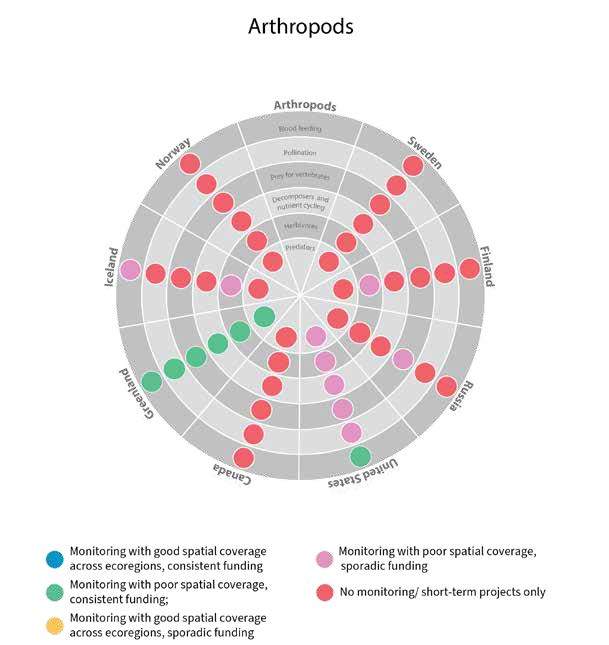Climate change is predicted to have a significant impact on invertebrate communities. Increases in temperature may increase development rates. This as well as changes in the duration snow lie may effect activity phenologies and result in a disconnection between flowering or bird nesting periods. Changes in precipitation may reduce soil moisture status, negatively impacting soil dwelling larval stages. Overall we see an environment in change and unravelling the connections and interactions is complicated. The difficulty of untangling the effects of climate and environmental changes is partly due to the extreme complexity of the invertebrate community (see page Ecosystem functions of invertebrates) and the lack of long-term data series for most species of invertebrate in the Arctic. With rapid and large population changes characteristic of many species of invertebrate, long term data on abundance and distribution is essential to be able to detect signals of environmental change in these animals. But see data provided below concerning Spilogona flies and Collembola from Greenland for an exception.
The Circumpolar Biodiversity Monitoring Plan (Christensen et al. 2013) and State of Artic terrestrial ecosystem report (Aronsson et al. 2021) attempted to simply the conceptualise this by grouping species into focal ecosystem components (see 2.5.5 Ecosystem functions). Species were classified into six groups. The chord diagram in this section demonstrates the high degree of interconnectiveness and hence the problems of projecting changes likely to climate change stressors.
Dr. Mark Gillespir
Lead author on the CAFF terrestrial biology report 2021, decribing the Circumpolar Biodiversity Monitoring Plan (CBMP), state of invertebrate monitoring in the Arctic and our understanding of the effects of environmental change on invertebrate abundance and biodiversity.
Click here for an interview with Dr. Mark Gillespie.
The greatest challenge in projecting the effects of environmental change on invertebrate diversity and abundance is the lack of monitoring and baseline data (Aronsson et al. 2021, Gillespie et al. 2020). Note that the data in these publications only comes from Greenland, Svalbard and Iceland as comparative data was largely lacking from other Arctic regions. Invertebrate populations often have wide interannual population fluctuations. With such natural variability, long time series observations are often required to detect changes in abundance. For the Arctic region these measurements are often absent with exception of Zackenberg and Nuuk in Greenland.
At Zackenberg a clear decrease in abundance of up to 80% has been seen in once genus of muscid flies that have a particular importance in pollination in Arctic regions while at Nuuk apparent increases in the densities of Collembola are occurring but with no change in species.
Professor Tom Christensen
The Circumpolar Biodiversity Monitoring Plan (click here for Prof Tom Christensen explaining the concept of the plan) aims to address the lack of monitoring for some groups and enhance implemented programmes for others.
Useful references, further reading
- Status and trends of terrestrial arthropod abundance and diversity in the North Atlantic region of the Arctic (Gillespie et al 2020a)
- Circumpolar terrestrial arthropod monitoring: A review of ongoing activities, opportunities and challenges, with a focus on spiders (Gillespie et al 2020b)
- Sate of the arctic terrestrial biodiversity report 2021 (CAFF-START report 2021)
- State of the Arctic Terrestrial Biodiversity: Key Findings and Advice for Monitoring (CAFF-START key findings 2021)
Video with Tom Barry, Executive secretary of CAFF, explaining the State of Arctic Terrestrial Biodiversity report 2021.
Conservation of Arctic Flora and Fauna
Collembola population trends in Kobbefjord from 2007 to 2017 in four different plant communities: a = Empetrum nigrum, d–= Salix glauca, g = Silene acaulis, j = Loiseleuria procumbens. Left hand panels: mean population abundance of total Collembola expressed as 103 individuals per m2.
Adapted form: Gillespie et al. 2020
- Aronsson, M., S. Heiðmarsson, H. Jóhannesdóttir, T. Barry, J. Braa, C.T. Burns, S.J. Coulson, C. Cuyler, K. Falk, H. Helgason, K.F. Lárusson, J.P. Lawler, P. Kulmala, D. MacNearney, E. Oberndorfer, V. Ravolainen, N.M. Schmidt, M. Soloviev, C. Coon and T. Christensen. 2021. State of the Arctic Terrestrial Biodiversity Report. Conservation of Arctic Flora and Fauna International Secretariat, Akureyri, Iceland. ISBN 978-9935-431-94-3
- Christensen, T., J. Payne, M. Doyle, G. Ibarguchi, J. Taylor, N.M. Schmidt, M. Gill, M. Svoboda, M. Aronsson, C. Behe, C. Buddle, C. Cuyler, A.M. Fosaa, A.D Fox, S. Heiðmarsson, P. Henning Krogh, J. Madsen, D. McLennan, J. Nymand, C. Rosa, J. Salmela, R. Shuchman, M. Soloviev, and M. Wedege. 2013. The Arctic Terrestrial Biodiversity Monitoring Plan. CAFF Monitoring Series Report Nr. 7. CAFF International Secretariat. Akureri, Iceland. ISBN 978-9935-431-26-4
- Gillespie, M.K.A., Alfredsson, M., Barrio, I.C., Bowden, J., Convey, P., Culler, L.E., Coulson, S.J., Krögh, P.H., Koltz, A.M., Koponen, S., Loboda, S., Marusik, Y., Sandstrøm, J.P., Sikes, D. & Høye, T.T. (2020) Status and trends of Arctic terrestrial arthropod diversity of the North Atlantic region. Ambio 49;718–731 https://doi.org/10.1007/s13280-019-01162-5









